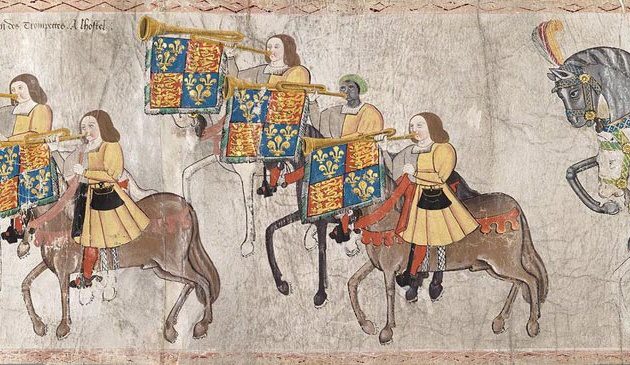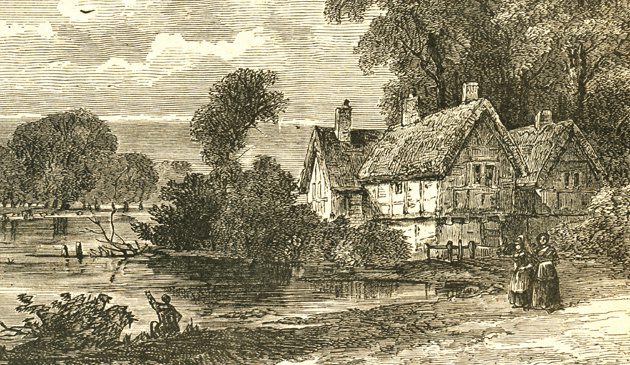The Port of London in the Tudor period

A view of the Thames c1550
Throughout the Middle Ages London’s import and export trade was with the near Continent. During the Tudor period the transformation began in which the city and its environs were to become the country’s leader in shipbuilding and the world’s premier financial centre. Trade difficulties with Continental neighbours led to voyages of discovery. In the following centuries these beginnings would lead to London becoming the capital of the world’s largest empire.
The riverside of the City of London had for centuries, by the Tudor period, been busy with ships and smaller vessels coming and going. Quays and warehouses lined the north bank of the river from the Tower up to London Bridge and above the bridge as far as Queenhithe. No doubt the sails and masts of vessels on the river could be seen from many points in the town.
The movement of goods up and down the narrow streets that descended to the river was handled by members of fellowships of porters. From the early 14th century the City had made rules regarding the unloading and measuring of corn at Queenhithe. Salt, coal and other goods such as fruit and shellfish, cloth, skins, and products in barrels were gradually regulated and their handling monopolised by different types of porter, who were freemen of the City.
The main Customs office for the entire port, where the officials based themselves, continued as before at Custom House Quay, upstream of the Tower. Official inspectors from there boarded each ship as it arrived to obtain a certificate of the vessel’s cargo and to calculate the duty.
London’s maritime trade with the Continental countries had risen steadily during the 12th and 13th centuries but had been hard hit during the period of the Hundred Years War that ended in the mid-1400s. From the latter part of that century commerce, such as the importing of French wine and the main exports of wool and cloth, began rapidly to rise again and growth continued during Tudor times. By 1500 about 45 percent of England’s wool and 70 percent of cloth exports were passing through the Port of London, much of it to Antwerp and Calais. There were many cloth-finishing workers around the Antwerp area, with a ready market for un-dyed, unfinished English broadcloths. During the 16th century exports of cloth became London’s dominant export.
Throughout the medieval period foreign merchants, often with superior ships and monopolies in certain goods and markets, dominated trade in and out of London. One such group was the Hanseatic League, or Hanse. They were a confederation of merchants from towns across northern Europe, from the Low Countries to Russia, and centred on Lübeck, who monopolised trade in the Baltic area. In 1493 Henry VI banned Flemish merchants from trading in London, a move that favoured the Hanse, who obtained the right to import Flemish cloth. This caused a riot by London merchants who had previously traded with the Flemings and the Hanse’s London base at the Steelyard in Upper Thames Street was attacked and temporarily destroyed.
A shipbuilding and repair industry, as well as associated trades such as rope and sail-making, had existed in London since Saxon times. As the city became more congested those enterprises moved further downstream. By the 14th century they were located in riverside hamlets at Ratcliffe, Shadwell, Limehouse, Poplar, Blackwall and Rotherhithe where ships could be pulled up on mud berths. Work on naval vessels was supervised by the Clerk of the King’s Ships who was based close by at the Tower of London. A Company of Shipwrights trade guild was established by the 15th century with their own meeting hall at Ratcliffe.
When Henry VIII was at war with France he found it inconvenient that his navy was based at Portsmouth, far from the Royal Armoury at the Tower of London. He decided that the ideal locations were close to his palace at Greenwich, at the Kent fishing villages of Deptford, Woolwich and Erith, which were also easier to defend than Portsmouth. These yards came to employ men with shipbuilding and repairing skills and there was a need for local suppliers and administrators with suitable knowledge. Initially the facilities on the Thames were rather small but Henry invested heavily in the navy and they grew ever larger and better-organised. During his reign the King’s Yard at Deptford expanded to 30 acres, including two wet-docks, three slips large enough for warships, forges, rope-making and other facilities. All these factors created an enlarged industry that was not only useful for naval shipping but for the wider Port of London. The area to the east of London therefore grew to become the ship-building capital of England at the end of the 16th century.
New methods of ship construction had been introduced at the end of the previous century, changing from the old ‘clinker’ to the newer ‘carvel’ type. Larger ships required additional sails, with more than one mast to support them. These new ships were more robust, with greater manoeuvrability, of larger capacity, faster, and cheaper to build. By 1545 all ships built on the Thames were in the new style.
Increased shipping on the Thames, and accusations that some dishonest pilots were being paid by rival merchants to run ships aground, created a need for new rules and standards to prevent accidents. A group of masters and mariners petitioned Henry VIII that regulation of pilots was required. From its foundation by royal charter in March 1514 responsibility for safety on the river was given to ‘The Master, Wardens and Assistants of the Guild or Fraternitie of the most glorious and blessed Trinitie and Saint Clement in the parish Church of Deptford Stronde in the County of Kent’. Trinity House, as they became known, were given the responsibility to provide pilotage – the safe guiding of ships by experienced pilots – along the Thames, particularly through its shifting sandbanks in the Estuary. Their work was funded by a levy on vessels entering the port, collected by Customs House in London. The only ship-owners not obliged to use their services were the Hanseatic League.
Queen Elizabeth extended the responsibilities of Trinity House. By the middle of the century they were involved in a number of river-related activities such as the provision of buoys and beacons to mark safe channels, the supply of ballast, and (from 1566) the authorisation of Thames watermen. Trinity House continues to be responsible for lighthouses, buoys and navigation around the coast in modern times.


